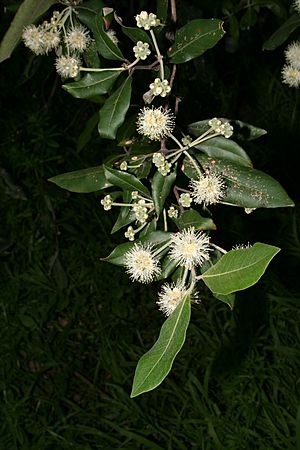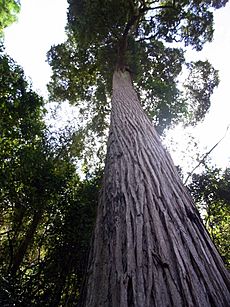Turpentine tree facts for kids
Quick facts for kids Turpentine tree |
|
|---|---|
 |
|
| Scientific classification | |
| Genus: |
Syncarpia
|
| Species: |
glomulifera
|
| Synonyms | |
|
Syncarpia laurifolia Ten. |
|
The Syncarpia glomulifera, often called the turpentine tree, is a tall tree found in New South Wales and Queensland, Australia. It belongs to the Myrtaceae family, which also includes eucalyptus trees. Turpentine trees can grow very tall, sometimes reaching up to 60 metres (200 feet). They usually prefer to grow in heavier soils. If you crush their leaves, they have a smell and taste a bit like turpentine. In spring, the tree produces creamy white flowers that grow in groups.
Contents
What is a Turpentine Tree?
The turpentine tree was first described by an English botanist named James Edward Smith in 1797. Later, a German botanist, Franz Josef Niedenzu, gave it its current scientific name, Syncarpia glomulifera, in 1893. People also call it luster, red turpentine, or red luster. There are two main types of this tree. One is common everywhere, and the other, called glabra, has smooth leaf undersides.
How to Spot a Turpentine Tree
A turpentine tree can grow very large and straight. It can reach heights of 45 to 55 metres (150–180 feet). Its trunk can be as wide as 1.3 to 1.5 metres (4–5 feet). If the soil is poor, it might grow as a smaller tree or even a bush.
The bark of the turpentine tree is thick and brown. It has deep lines running down the trunk. Its leaves grow in pairs, opposite each other on the stems. They look like groups of four leaves. The leaves are thick, about 7–10 cm (2.5–4 inches) long. Their top side is a dull dark green, and the bottom side is much lighter.
Flowers and Fruit
Turpentine trees flower from August to December, with most flowers appearing in September. The flowers are creamy white. They grow together in groups of seven. After the flowers, the tree produces woody fruits. These fruits are round capsules, about 1 to 2 cm (0.4–0.8 inches) wide. They ripen in the summer.
Where Turpentine Trees Live
Turpentine trees are found in eastern Queensland and New South Wales, Australia. They grow from Atherton in the north down to Murramarang National Park in the south. In some northern areas, they grow in smaller, separate groups.
These trees often grow in forests that are a mix of rainforest and wet sclerophyll forest. Here, they stand tall above other trees. They can be found alongside trees like flooded gum, tallowwood, and brush box. On poorer soils, they might grow in drier forests with trees like smooth-barked apple.
Turpentine trees can grow in many different types of soil. They prefer soils with good nutrients, like clay soil. They grow well in valleys and flat areas. In the Sydney area, they grow up to 300 metres (1000 feet) above sea level. In northern Queensland, they can be found as high as 900 metres (3000 feet).
The turpentine tree is a very important part of the Sydney Turpentine-Ironbark Forest. This forest is a special type of ecological community that is critically endangered.
The biggest known turpentine tree is in the Barrington Tops National Park. It has a trunk that is 7.9 metres (26 feet) around. This giant tree is 58 metres (190 feet) tall.
Life Cycle and Ecology
Turpentine tree flowers are pollinated by different animals. Native bees and European honeybees help pollinate them. Flies and moths might also help. Large bats, like the grey-headed flying fox and little red flying fox, also visit the flowers. Birds such as the rainbow lorikeet and noisy miner feed on the nectar.
After a bushfire, the turpentine tree can grow back. It resprouts from its base and from buds under its bark. Turpentine trees are known to live for a very long time, sometimes up to 500 years.
Uses of Turpentine Wood
The wood from turpentine trees is very strong and lasts a long time. It is used for things that need to be durable, like heavy-traffic floors. It is also used for poles and wharves, which are structures built over water. This wood is good for these uses because it resists damage from sea creatures and termites. It is also one of the hardest timbers to set on fire.
Turpentine trees are tough and can adapt to different conditions. They can handle heavy soils and even frost. Because they provide good shade with their thick leaves, they are a good choice for large gardens and parks.
See also
 In Spanish: Syncarpia glomulifera para niños
In Spanish: Syncarpia glomulifera para niños


